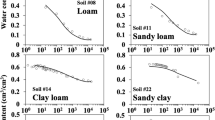Abstract
A new method for the rapid plotting of the soil water retention curve (SWRC) has been proposed that considers the soil water as an environment limited by the soil solid phase on one side and by the soil air on the other side. Both contact surfaces have surface energies, which play the main role in water retention. The use of an idealized soil model with consideration for the nonequilibrium thermodynamic laws and the aerodynamic similarity principles allows us to estimate the volumetric specific surface areas of soils and, using the proposed pedotransfer function (PTF), to plot the SWRC. The volumetric specific surface area of the solid phase, the porosity, and the specific free surface energy at the water-air interface are used as the SWRC parameters. Devices for measuring the parameters are briefly described. The differences between the proposed PTF and the experimental data have been analyzed using the statistical processing of the data.
Similar content being viewed by others
References
V. V. Alekseev, V. M. Sirotkin, I. I. Maksimov, and P. N. Pakulin, “Dimensionless values characterizing the soil state and the mechanical impact of tillage tools and machinery on the soil,” in Ecological Aspects of Mechanization of Plant Production, X Intern. Symp., pp. 141–146 (Warsaw, 2003).
B. V. Derjaguin, N. V. Churaev, and V. M. Muller, Surface Forces (Plenum Press, New York, 1987).
E. B. Skvortsova, “Changes in the geometric structure of pores and aggregates as indicators of the structural degradation of cultivated soils,” Eur. Soil Sci. 42(11), 1254–1262 (2009).
E. B. Skvortsova and V. F. Utkaeva, “Soil pore space arrangement as a geometric indicator of soil structure,” Eur. Soil Sci. 41(11), 1198–1204 (2008).
A. V. Smagin, “Column-centrifugation method for determining water retention curves of soils and disperse sediments,” Eur. Soil Sci. 45(4), 416–422 (2012).
Theory and Methods of Soil Physics, Ed. by E. V. Shein and L. O. Karpachevskii (Grif i K, Moscow, 2007) [in Russian].
E. V. Shein, “The particle-size distribution in soils: problems of the methods of study, interpretation of the results, and classification,” Eur. Soil Sci. 42(3), 284–291 (2009).
M. R. Deinert, A. Dathe, J.-Y. Parlange, et al., “Capillary pressure in a porous medium with distinct pore surface and pore volume fractal dimensions,” Phys. Rev. 77 (2008).
Development of Pedotransfer Functions in Soil Hydrology, Ed. by Ya. Pachepsky and W. J. Rawls, Developments in Soil Science 30 (2004).
K. Seki, “SWRC fit—a nonlinear fitting program with a water retention curve for soils having unimodal and bimodal pore structure,” Hydrol. Earth Syst. Sci. Discuss. 4(1), 407–437 (2007).
T. Vogel, M. T. van Genuchten, and M. Cislerova, “Effect of the shape of the soil hydraulic functions near saturation on variably-saturated flow predictions,” Adv. Water Resour. 24(2), 133–144 (2000).
Author information
Authors and Affiliations
Corresponding author
Additional information
Original Russian Text © V.V. Alekseev, I.I. Maksimov, 2013, published in Pochvovedenie, 2013, No. 7, pp. 822–828.
Rights and permissions
About this article
Cite this article
Alekseev, V.V., Maksimov, I.I. Aerodynamic method for obtaining the soil water retention curve. Eurasian Soil Sc. 46, 751–757 (2013). https://doi.org/10.1134/S1064229313070028
Received:
Published:
Issue Date:
DOI: https://doi.org/10.1134/S1064229313070028




